MERCEDES-BENZ CLA 2018 Repair Manual
Manufacturer: MERCEDES-BENZ, Model Year: 2018, Model line: CLA, Model: MERCEDES-BENZ CLA 2018Pages: 326, PDF Size: 7.97 MB
Page 61 of 326
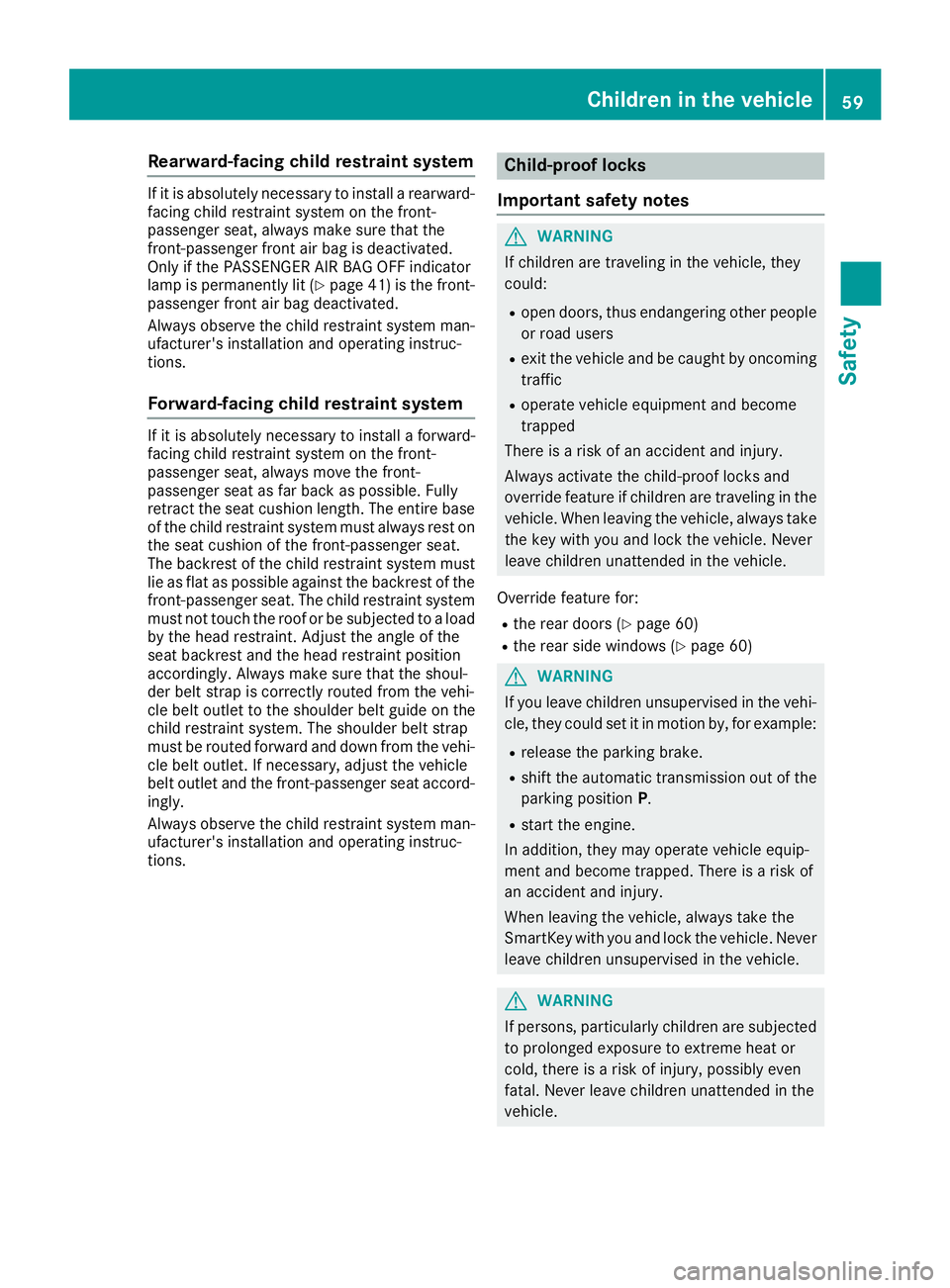
Rearward-facin gc hild restraint systemIf it is absolutely necessary to install ar earward-
facing child restraint system on the front-
passenger seat, always make sure that the
front-passenger front ai rb ag is deactivated.
Only if the PASSENGER AIR BAG OFF indicator
lamp is permanently li t( Y
page 41 )i st he front-
passenger front ai rb ag deactivated.
Alway so bserve the child restraint system man-
ufacturer's installation and operating instruc-
tions.
Forward-facing child restraint system If it is absolutely necessary to install af orward-
facing child restraint system on the front-
passenger seat, always move the front-
passenger sea ta sf ar back as possible .F ully
retract the sea tc ushio nl en gth. The entir eb as e
of the child restraint system mus ta lway sr es to n
the sea tc ushio noft he front-passenger seat.
The backrest of the child restraint system must
li easf la ta sp ossible against the backrest of the
front-passenger seat. The child restraint system
mus tn ot touch the roo forbes ub jecte dtoal oa d
by the hea dr estraint. Adjust the angle of the
sea tb ac krest and the hea dr estraint position
accordingly .A lway sm ake sure that the shoul-
der bel ts tra pisc orrectly routed from the vehi-
cle bel to ut let to the shoulder bel tg uide on the
child restraint system. The shoulder bel ts trap
mus tb er outed forward and dow nf rom the vehi-
cle bel to ut let. If necessary, adjust the vehicle
bel to ut let and the front-passenger sea ta ccord-
ingly.
Alway so bserve the child restraint system man-
ufacturer's installation and operating instruc-
tions. Child-proof locks
Important safety notes
G WARNING
If children are traveling in the vehicle, they
could: R
ope nd oors, thu se ndangering othe rp eople
or roa du se rs R
exi tt he vehicl ea nd be caught by oncoming
traffic R
operate vehicl ee quipment and become
trapped
There is ar is kofana ccident and injury.
Alway sa ctivate the child-proof locks and
overrid ef eature if children are traveling in the
vehicle. Whe nl ea ving the vehicle, always take
the key with yo ua nd lock the vehicle. Never
leave children unattende dint he vehicle.
Overrid ef eature for: R
the rea rd oors ( Y
page 60) R
the rea rs id ew in dow s( Y
page 60)
G WARNING
If yo ul ea ve children unsupervised in the vehi-
cle ,t hey could set it in motion by ,f or example:R
release the parking brake. R
shift the automatic transmissio no ut of the
parking position P . R
star tt he engine.
In addition, they may operate vehicl ee quip-
ment and become trapped .T here is ar is ko f
an accident and injury.
Whe nl ea ving the vehicle, always take the
SmartKey with yo ua nd lock the vehicle. Never
leave children unsupervised in the vehicle.
G WARNING
If persons ,p ar ticularly children are subjected
to prolonged exposure to extreme hea to r
cold, there is ar is kofi njury, possibly even
fatal. Neve rl ea ve children unattende dint he
vehicle.Childre nint he vehicle 59
Safety Z
Page 62 of 326
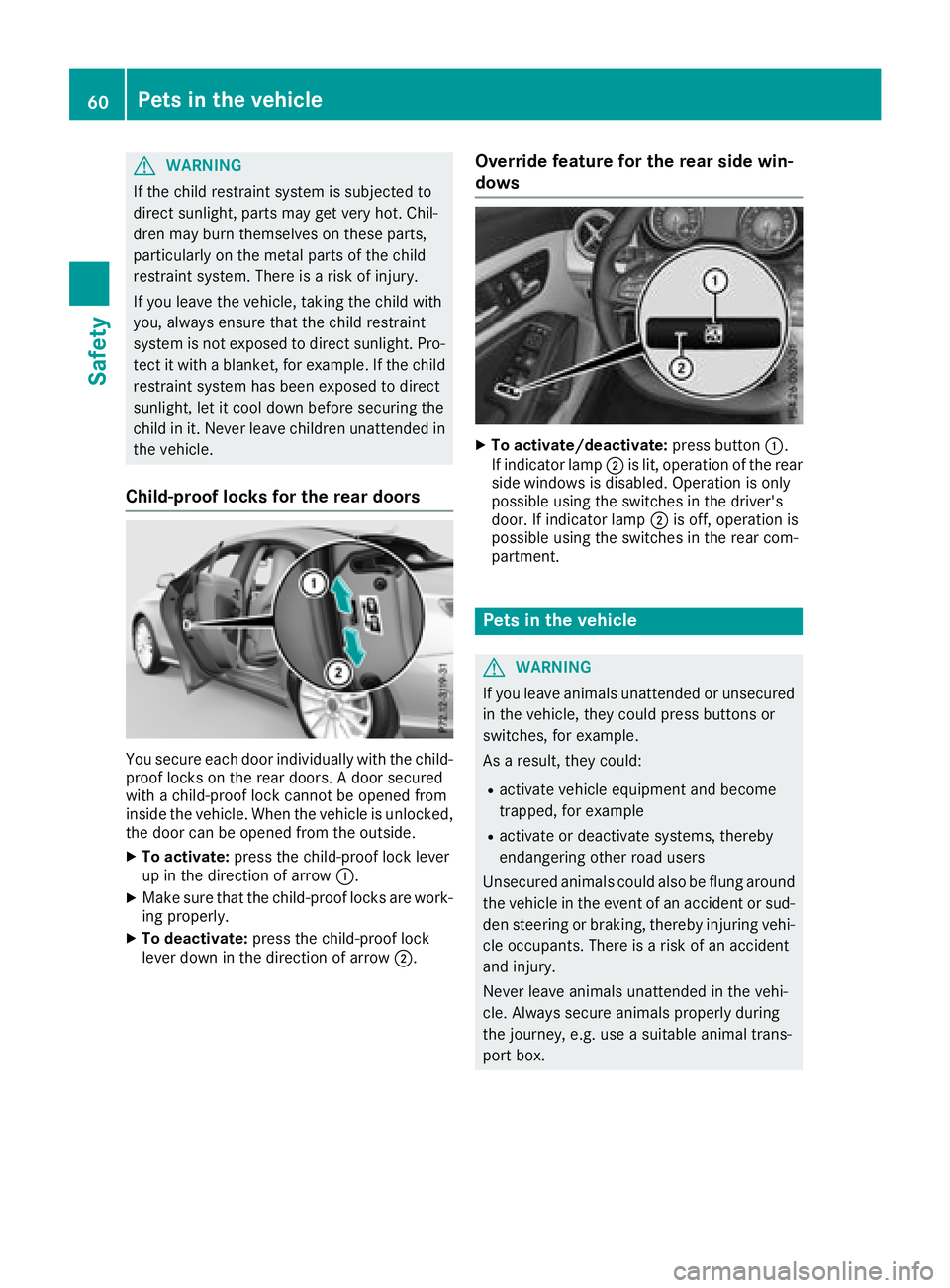
G WARNING
If the child restraint system is subjected to
direct sunlight, parts may get very hot. Chil-
dren may burn themselves on these parts,
particularl yont he metal parts of the child
restraint system. There is ar isk of injury.
If you leave the vehicle, taking the child with
you ,a lway se nsure that the child restraint
system is not expose dtod irect sunlight. Pro-
tect it with ab lanket, for example. If the child
restraint system has been expose dtod irect
sunlight, let it cool dow nb efore securing the
child in it. Never leave children unattended in
the vehicle.
Child-proof locks for the rear doors
You secure each door individually with the child-
proof locks on the rear doors. Ad oor secured
with ac hild-proof lock cannot be opened from
insid et he vehicle. When the vehicl eisu nlocked,
the door can be opened from the outside. X
To activate: press the child-proof lock lever
up in the direction of arrow �C .X
Make sure that the child-proof locks are work-
ing properly. X
To deactivate: press the child-proof lock
leve rd ow nint he direction of arrow �D . Override feature for the rear side win-
dows X
To activate/deactivate: press button �C .
If indicator lamp �D is lit, operation of the rear
side windows is disabled. Operation is only
possible using the switches in the driver's
door. If indicator lamp �D is off, operation is
possible using the switches in the rear com-
partment.
Pets in the vehicle
G WARNING
If you leave animals unattended or unsecured
in the vehicle, they coul dp ress buttons or
switches, for example.
As ar esult, they could: R
activate vehicl ee quipment and become
trapped, for example R
activate or deactivate systems ,t hereby
endangering other road users
Unsecure da nimals coul da ls obef lung around
the vehicl eint he event of an accident or sud-
den steering or braking, thereby injuring vehi-
cle occupants. There is ar isk of an accident
and injury.
Never leave animals unattended in the vehi-
cle. Always secure animals properly during
the journey ,e .g. use as uitable anima lt rans-
port box.60
Pets in the vehicle
Safety
Page 63 of 326
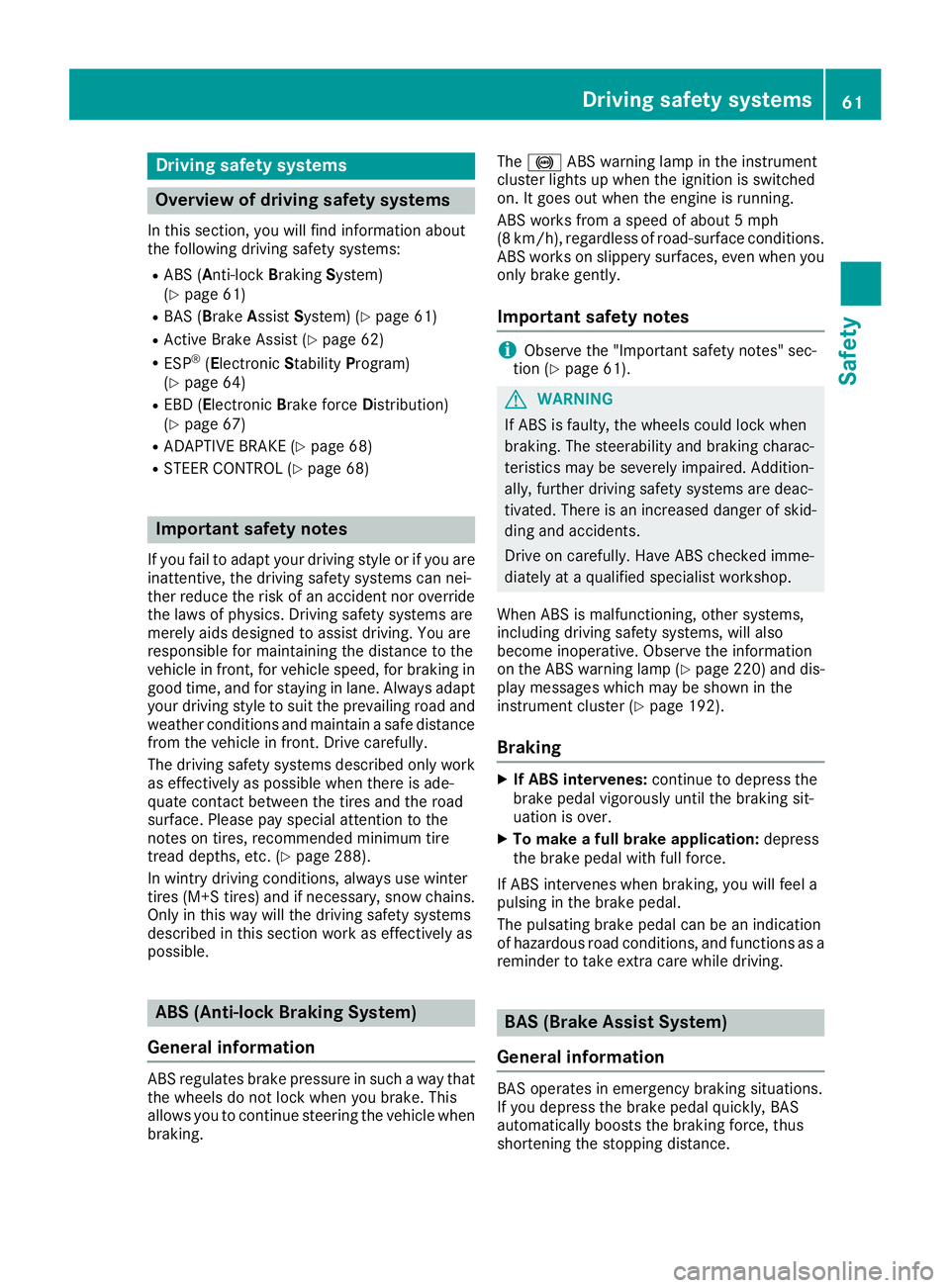
Drivin gs af et ys ystems
Overview of drivin gs af et ys ystemsIn this section ,y ou will fin di nformati on about
th ef ol lowin gd rivin gs afet ys ystems :R
AB S( A nti-lock B rakin g S ystem)
( Y
page 61) R
BA S( B rak e A ssist S ystem) ( Y
page 61)R
Active Brak eA ss is t( Y
page 62 )R
ES P ®
( E lectronic S ta bility P ro gram)
( Y
page 64) R
EB D( E lectroni c B rak ef orce D istribution )
( Y
page 67 )R
ADAPTIV EB RAKE ( Y
page 68 )R
STEE RC ONTROL ( Y
page 68)
Important safet yn otesIf you fail to adapt your drivin gs ty le or if you are
inattentive ,t he drivin gs afet ys ystems can nei-
ther reduce th er is kofana cciden tn or override
th el aws of physics. Driving safet ys ystems are
merely aids designed to assist driving. You are
responsible fo rm aintainin gt he distanc etot he
vehicle in front, fo rv ehicle speed, fo rb raking in
goo dt im e, and fo rs ta yin ginl ane. Always adapt
your drivin gs ty le to suit th ep revailin gr oa da nd
weather condition sa nd maintain as af ed istanc e
from th ev ehicle in front. Drive carefully.
The drivin gs afet ys ystems described only wor k
as effectively as possible when there is ade-
quat ec ontac tb etween th et ir es and th er oa d
surface. Please pay special attention to th e
note sont ir es ,r ecommended minimum tire
tread depths, etc. ( Y
page 288).
In wintr yd rivin gc onditi ons, always use winte r
tires (M+ St ir es )a nd if necessary ,s now chains.
Onl yint hi sw ay will the driving safety systems
describe dint hi ss ection work as effectively as
possible.
ABS (Anti-lock Brakin gS ystem)
General information
ABS regulate sb rake pressure in such aw ay that
the wheels do not lock when yo ub rake. This
allows yo utoc ontinue steering the vehicl ew he n
braking. The �% ABS warning lamp in the instrument
cluster lights up when the ignition is switched
on. It goe so ut when the engine is running.
ABS works from as peed of abou t5m ph
(8 km/h), regardless of road-surface conditions.
ABS works on slippery surfaces, eve nw he ny ou
onl yb rake gently.
Important safety notes
i Observe the "Important safety notes "s ec-
tio n( Y
page 61).
G WARNING
If ABS is faulty ,t he wheels could lock when
braking .T he steerability and braking charac-
teristic sm ay be severely impaired .A ddition-
ally ,f urther driving safety system sa re deac-
tivated .T here is an increased danger of skid-
ding and accidents.
Driv eonc arefully. Hav eA BS checked imme-
diately at aq uali fied specialist workshop.
Whe nA BS is malfunctioning ,o the rs ys tems,
including driving safety systems, will also
become inoperative. Observe the information
on the ABS warning lamp ( Y
page 220 )a nd dis-
play messages which ma ybes hown in the
instrument cluster ( Y
page 192).
Braking X
If ABS intervenes: continue to depress the
brake peda lv igorously unti lt he braking sit-
uatio ni so ver. X
To make af ul lb rake application: depress
the brake peda lw it hf ul lf orce.
If ABS intervene sw he nb raking ,y ou will fee la
pulsing in the brake pedal.
The pulsating brake peda lc an be an indication
of hazardou sr oa dc onditions, and functions as a
reminder to take extra car ew hile driving.
BAS (Brak eA ssis tS ystem)
General information
BAS operates in emergency braking situations.
If yo ud ep ress the brake peda lq ui ckly, BAS
automaticall yb oo sts the braking force ,t hus
shortening the stopping distance.Driving safety systems 61
Safety Z
Page 64 of 326
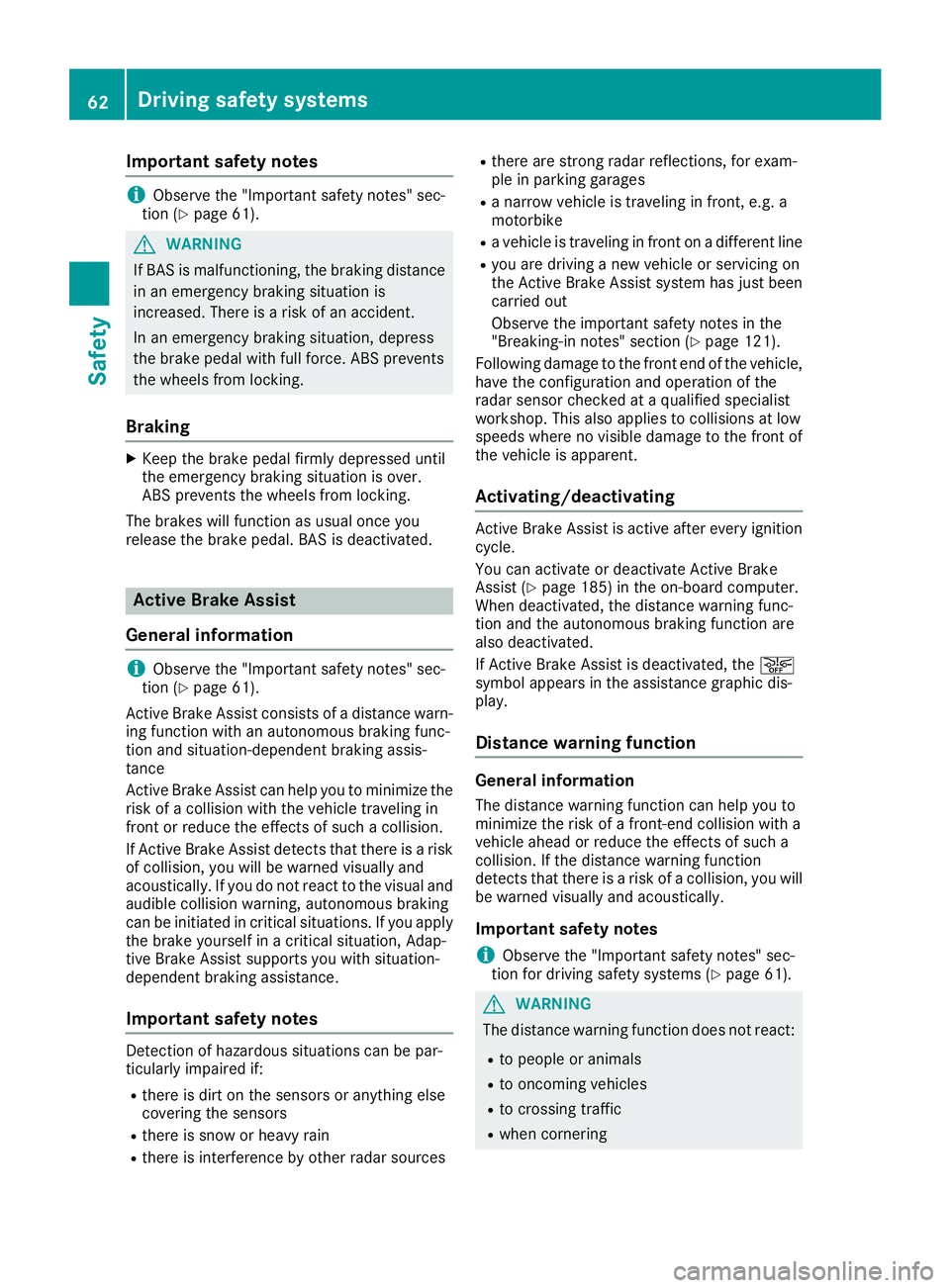
Important safety notes
i Observ et he "Importan ts afet yn otes "s ec -
tion ( Y
page 61).
G WARNIN G
If BA Sism alfunctioning ,t he braking distanc e
in an emergenc yb raking situation is
increased. Ther eisar is kofana ccident.
In an emergenc yb raking situation ,d epress
th eb rak ep edal wit hf ull force .A BS prevents
th ew heels from locking.
Braking X
Kee pt he brak ep edal firmly depressed until
th ee mergenc yb raking situation is over.
AB Sp revents th ew heels from locking.
The brakes will function as usual once you
release th eb rak ep edal .B AS is deactivated.
Active Brak eA ssist
General information
i Observ et he "Importan ts afet yn otes "s ec -
tion ( Y
page 61).
Active Brake Assist consist sofad istanc ew arn -
ing function wit hana utonomous braking func-
tion and situation-dependen tb raking assis-
tance
Active Brake Assist can help you to minimiz et he
ris kofac ol lision wit ht he vehicl et ra veling in
fron torr educe th ee ffects of suc hac ol lision .
If Active Brake Assist detects that there is ar is k
of collision ,y ou will be warned visually and
acoustically. If you do no tr eac ttot he visual and
audible collision warning ,a utonomous braking
can be initiate dinc riti cal situations. If you apply
th eb rak ey ourself in ac riti cal situation ,A da p-
tive Brake Assist support sy ou wit hs ituation -
dependen tb raking assistance.
Important safety notes
Detection of hazardous situation sc an be par-
ticularly impaired if: R
there is dirt on th es ensor sora nythin ge lse
covering th es ensor sR
there is snow or heav yr ainR
there is interferenc ebyo th er radar source s R
there are stron gr adar reflections, for exam-
ple in parking garages R
an arrow vehicl eist ra veling in front, e.g. a
motorbike R
av ehicl eist ra veling in fron tonad ifferen tl in eR
you are driving an ew vehicl eors ervicing on
th eA ctiv eB ra ke Assist system has jus tb een
carrie do ut
Observ et he important safet yn otes in th e
"Breaking-in notes" section ( Y
page 121).
Followin gd amag etot he fron te nd of th ev ehicle,
hav et he configuration and operation of th e
radar sensor checke dataq ualified specialist
workshop. This also applie stoc ol lision satl ow
speeds wher enov isible damag etot he fron to f
th ev ehicl eisa pparent.
Activating/deactivating Active Brake Assist is active after every ignition
cycle.
You can activat eord eactivat eA ctiv eB ra ke
Assist ( Y
page 185) in th eo n-bo ard computer.
When deactivated, th ed istanc ew arning func-
tion and th ea utonomous braking function are
also deactivated.
If Active Brake Assist is deactivated, th e �
Page 65 of 326
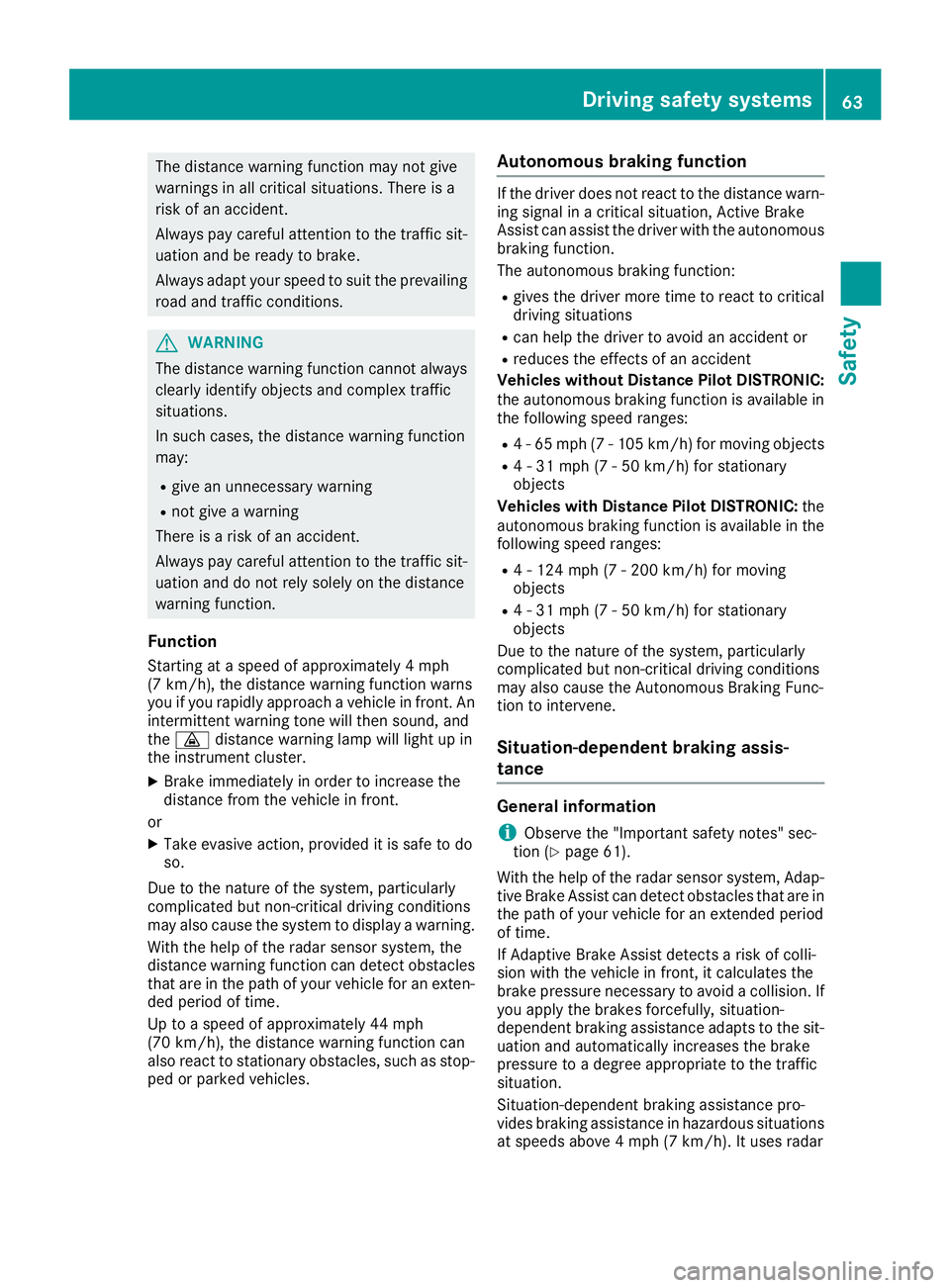
The distance warning function may not give
warnings in all critical situations. There is a
risk of an accident.
Always pay careful attention to the traffic sit-
uation and be ready to brake.
Always adapt your speed to suit the prevailing
road and traffic conditions.
G WARNING
The distance warning function cannot always
clearly identify object sa nd complex traffic
situations.
In such cases, the distance warning function
may: R
give an unnecessary warning R
not give aw arning
There is ar isk of an accident.
Always pay careful attention to the traffic sit-
uation and do not rely solely on the distance
warning function.
Function Starting at as peed of approximately 4m ph
(7 km/h), the distance warning function warns
you if you rapidly approach av ehicle in front .A n
intermittent warning ton ew ill then sound, and
the �
Page 66 of 326
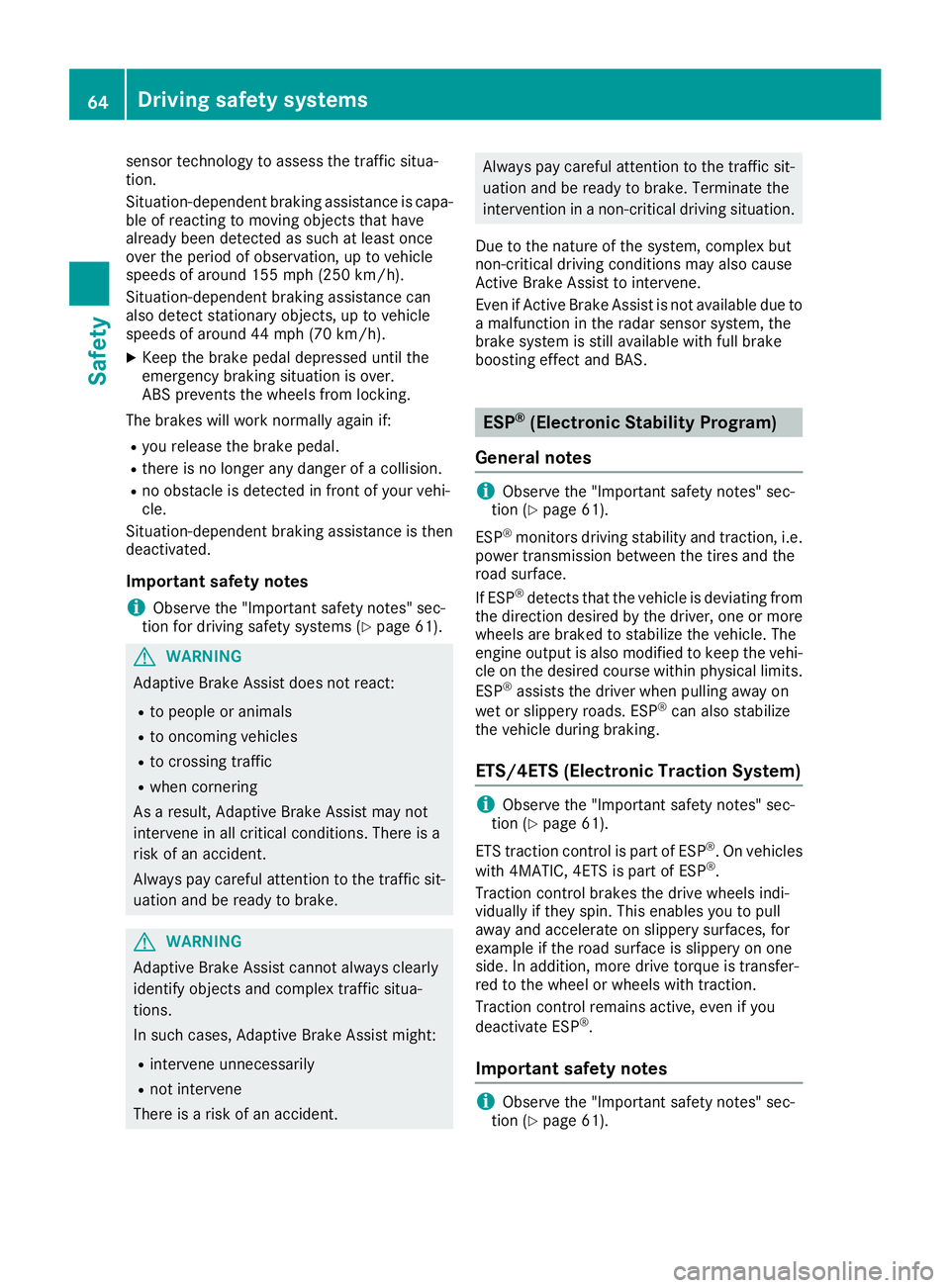
sensor technology to assess the traffic situa-
tion.
Situation-dependent braking assistance is capa-
ble of reacting to moving objects that have
alread yb een detected as such at least once
over the period of observation, up to vehicle
speeds of around 155 mph (250 km/h).
Situation-dependent braking assistance can
also detect stationary objects, up to vehicle
speeds of around 44 mph (70 km/h). X
Keep the brake pedal depressed until the
emergency braking situation is over.
ABS prevents the wheels from locking.
The brakes will work normally agai ni f:R
you release the brake pedal. R
there is no longer any danger of ac ollision.R
no obstacle is detected in front of your vehi-
cle.
Situation-dependent braking assistance is then
deactivated.
Important safety notes
i Observe the "Important safety notes" sec-
tion for driving safety systems ( Y
page 61).
G WARNING
Adaptive Brake Assist does not react: R
to people or animals R
to oncoming vehicles R
to crossing traffic R
when cornering
As ar esult, Adaptive Brake Assist may not
intervene in all critical conditions. There is a
risk of an accident.
Always pay careful attention to the traffic sit-
uation and be ready to brake.
G WARNING
Adaptive Brake Assist cannot always clearly
identify objects and complex traffic situa-
tions.
In such cases, Adaptive Brake Assist might: R
intervene unnecessarily R
not intervene
There is ar isk of an accident. Always pay careful attention to the traffic sit-
uation and be ready to brake. Terminate the
intervention in an on-critical driving situation.
Due to the nature of the system, complex but
non-critical driving conditions may also cause
Active Brake Assist to intervene.
Even if Active Brake Assist is not available due to
am alfunction in the radar sensor system, the
brake system is still available with full brake
boosting effect and BAS.
ESP ®
(Electronic Stability Program)
General notes
i Observe the "Important safety notes" sec-
tion ( Y
page 61).
ESP ®
monitors driving stability and traction ,i .e.
power transmission between the tires and the
road surface.
If ESP ®
detects that the vehicle is deviating from
the direction desired by the driver, one or more
wheels are braked to stabilize the vehicle. The
engine output is also modified to keep the vehi-
cle on the desired course within physical limits.
ESP ®
assists the driver when pulling awa yo n
wet or slippery roads. ESP ®
can also stabilize
the vehicle during braking.
ETS/4ETS (Electronic Traction System)
i Observe the "Important safety notes" sec-
tion ( Y
page 61).
ETS traction control is part of ESP ®
.Onv ehicles
with 4MATIC, 4ETS is part of ESP ®
.
Traction control brakes the drive wheels indi-
vidually if they spin. This enables you to pull
awa ya nd accelerate on slippery surfaces, for
example if the road surface is slippery on one
side. In addition, more drive torque is transfer-
red to the wheel or wheels with traction.
Traction control remains active, even if you
deactivate ESP ®
.
Important safety notes
i Observe the "Important safety notes" sec-
tion ( Y
page 61).64
Driving safety systems
Safety
Page 67 of 326
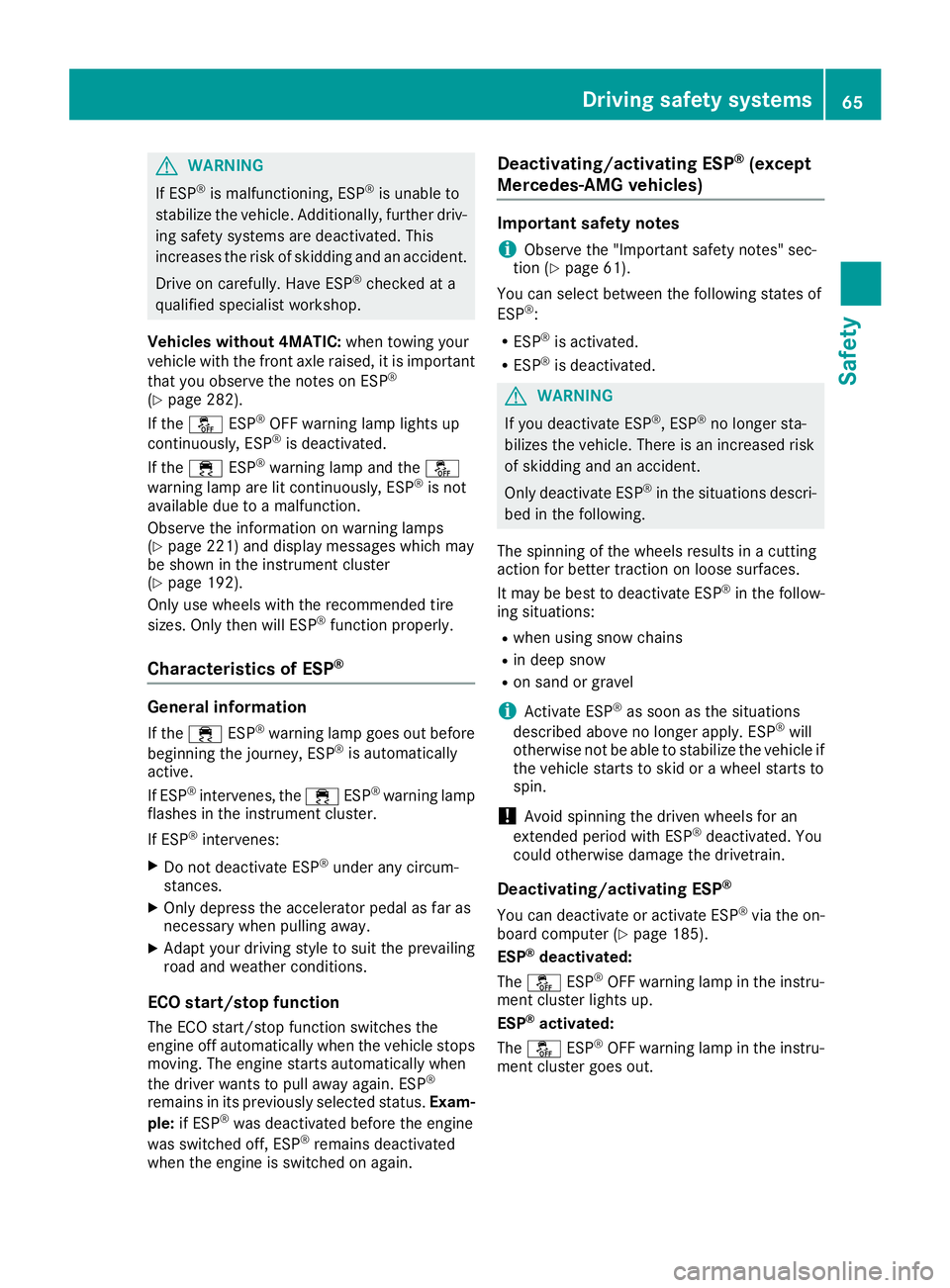
G WARNING
If ESP ®
is malfunctioning, ESP ®
is unable to
stabilize the vehicle. Additionally, further driv-
ing safety systems are deactivated. This
increases the risk of skidding and an accident.
Drive on carefully .H ave ESP ®
checked at a
qualified specialist workshop.
Vehicles without 4MATIC: when towing your
vehicl ew ith the front axle raised, it is important
that you observe the notes on ESP ®
( Y
pag e2 82).
If the �
Page 68 of 326
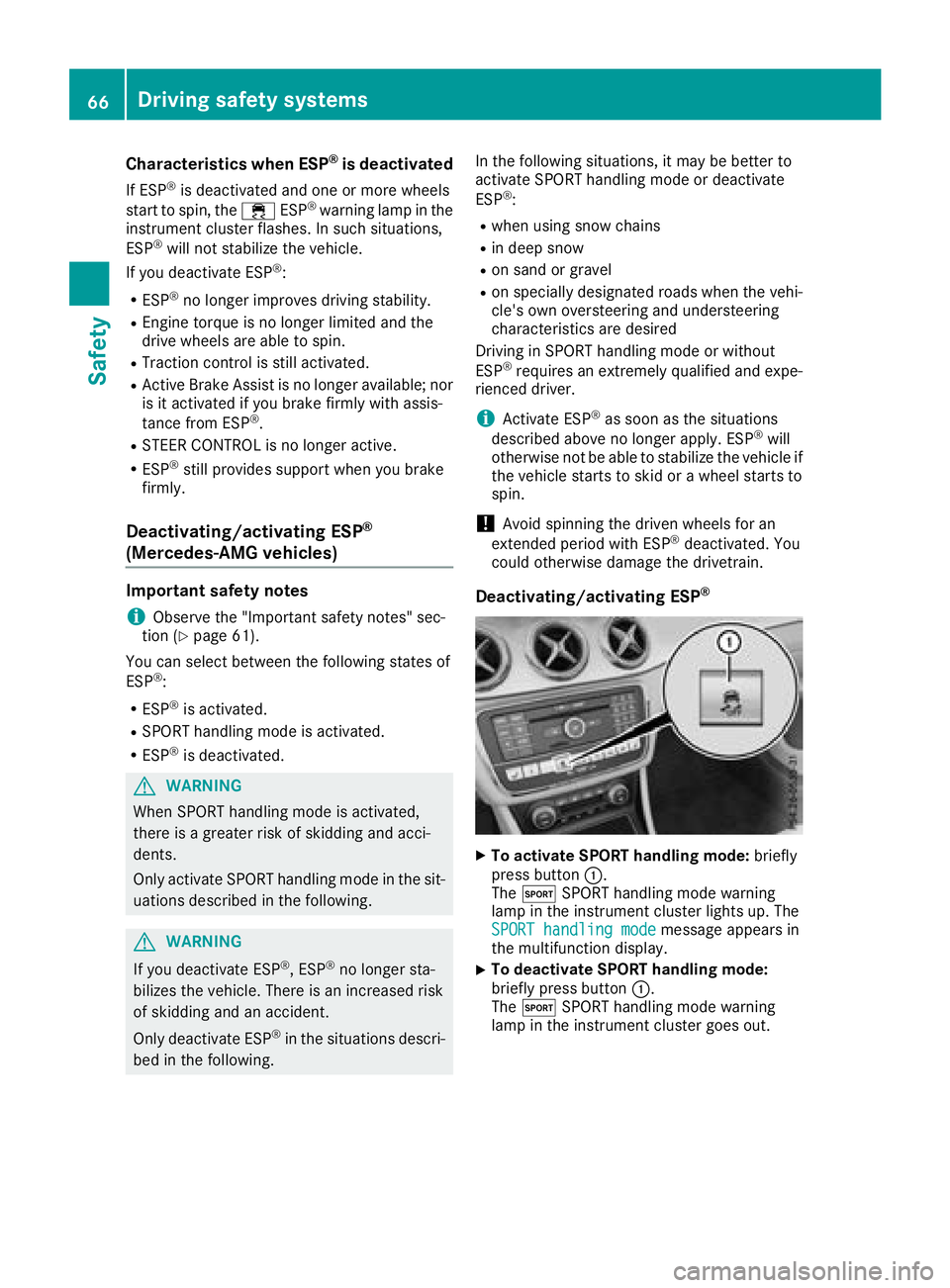
Characteristics when ESP ®
is deactivatedIf ESP ®
is deactivate da nd on eorm or ew heels
start to spin ,t he �
Page 69 of 326
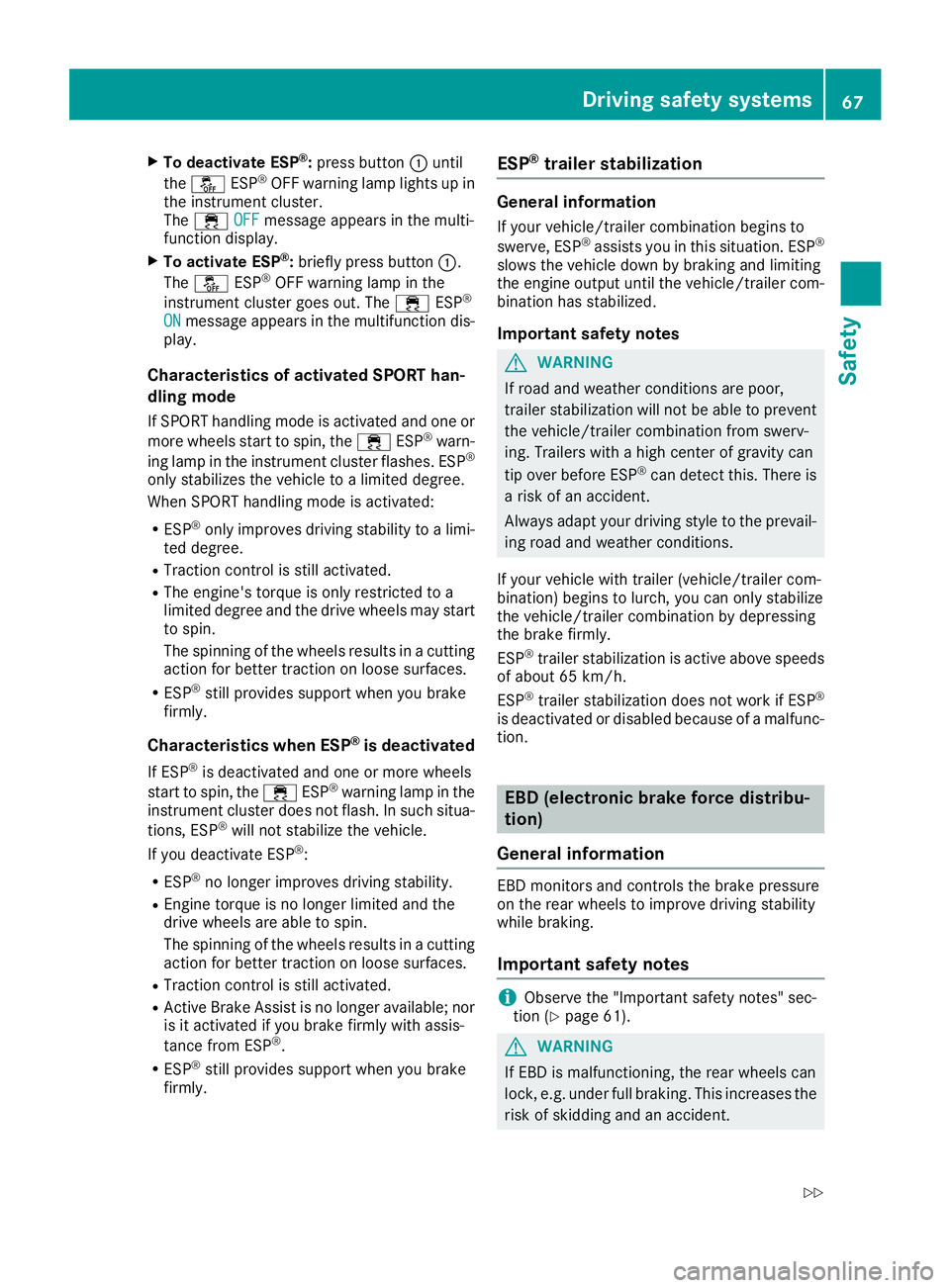
X
To deactivate ESP ®
: press button �C until
the �
Page 70 of 326
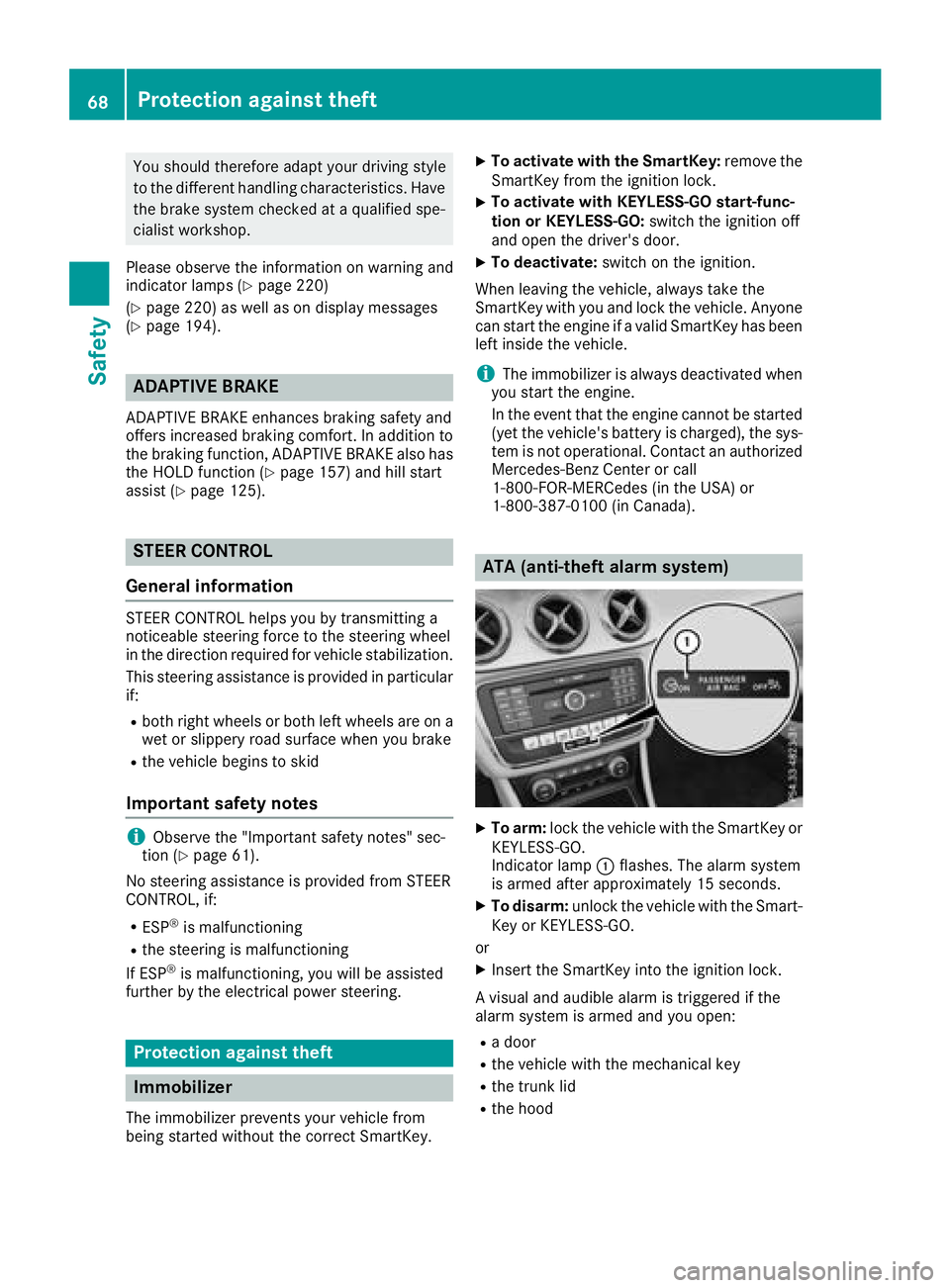
You should therefore adapt your drivin gs tyle
to the differen th andlin gc haracteristics. Have
the brak es yste mc hecked at aq ualified spe-
cialist workshop.
Please observ et he information on warnin ga nd
indicator lamps ( Y
page 220)
( Y
page 220) as well as on display messages
( Y
page 194).
ADAPTIVE BRAKE ADAPTIVE BRAKE enhances braking safet ya nd
offers increased braking comfort .Ina ddition to
the braking function ,A DA PTIVE BRAKE also has
the HOL Df unction ( Y
page 157) and hill start
assist ( Y
page 125).
STEER CONTROL
Genera li nformationSTEER CONTROL helps you by transmitting a
noticeable steerin gf orc etot he steerin gw heel
in the direction required for vehicle stabilization.
This steerin ga ssistanc eisp rovided in particular
if: R
both right wheels or both left wheels are on a
wet or slippery road surfac ew hen you brakeR
the vehicle begins to skid
Important safet yn otes
i Observe the "Importan ts afet yn otes" sec-
tion ( Y
page 61).
No steerin ga ssistanc eisp rovided from STEER
CONTROL, if: R
ESP ®
is malfunctioningR
the steerin gism alfunctioning
If ESP ®
is malfunctioning, you will be assisted
further by the electrical power steering.
Protection against theft
Immobilizer
The immobilizer prevent sy our vehicle from
being started without the correc tS martKey. X
To activat ew ith th eS martKey: remove the
SmartKey from the ignition lock. X
To activat ew ith KEYLESS-GO start-func-
tion or KEYLESS-GO: switc ht he ignition off
and open the driver's door. X
To deactivate: switc hont he ignition.
When leaving the vehicle, always tak et he
SmartKey with you and lock the vehicle. Anyone
can star tt he engin eifav alid SmartKey has been
left inside the vehicle.
i The immobilizer is always deactivate dw hen
you star tt he engine.
In the even tt hat the engin ec annot be started
(yet the vehicle's battery is charged), the sys-
tem is not operational. Contact an authorized
Mercedes-Ben zC enter or call
1-800-FOR-MERCedes (in the USA )o r
1-800-387-010 0( in Canada).
ATA (anti-theft alar ms ystem)
X
To arm: lock the vehicle with the SmartKe yo r
KEYLESS-GO.
Indicator lamp �C flashes. The alarm system
is armed after approximately 15 seconds. X
To disarm: unlock the vehicle with the Smart-
Key or KEYLESS-GO.
or X
Insert the SmartKe yi nt ot he ignition lock.
Av isual and audible alarm is triggered if the
alarm system is armed and you open: R
ad oor R
the vehicle with the mechanical key R
the trun kl id R
the hood68
Protection against theft
Safety